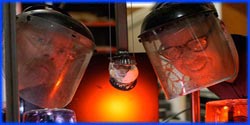


Premier Date: November 19, 2008
plausible
Because this experiment would last several days and the subject would be exposed to the sun, Adam and Jamie decided they did not want to use an animal carcass. First they used a force gauge to determine how much pressure was needed to puncture the skin of animal flesh. They discovered that it took the same amount of force to pierce a torso made out of ballistic gelatin. Next they planted bamboo shoots in a greenhouse constructed on the M5 roof, and suspended the gel torso over the bamboo. After only three days, a couple of bamboo shoots had pierced the torso’s back. However, the bamboo died before making it all the way through the torso, apparently because because the sun melted the gel and it poisoned the plants. To fix this problem, they made a more sophisticated torso with ballistic gel inside mannequin shell with holes for the bamboo to enter. The bamboo grew right through the torso and rose to a height of about ten feet. Both Adam and Jaime agreed this would be extremely painful for a person to endure and declared the myth plausible.
busted
Tory, Grant and Kari went to the Alameda County bomb range to test the myth, which is featured in an episode of the British TV show Brainiac: Science Abuse. The Brainiac experiment purported that two grams of rubidium or cesium dropped into a bathtub filled with water would cause hand grenade-like explosion. However, the MythBusters could not recreate the rubidium or cesium explosions, despite using 25 grams. Instead of an explosion, the chemical reaction caused a brief flame, and a release of hydrogen gas before fizzling out. The team also tried two other alkali metals, sodium and potassium. They dropped 2.5 kilograms (5.5 lb) of each metal into a bathtub. The reactions were violent enough to crack the bathtub, but not nearly as powerful as a hand grenade, so the myth was declared busted. The discrepancies between the MythBusters and Brainiac results arose from forged results; the Brainiac staff has admitted to using actual explosives create more spectacular programming.
busted
To test this myth, Adam and Jamie swallowed internal thermometers which contained tiny transmitters that sent their core body temperature to a digital display. They also used a thermographic camera to record the temperature of each others’ face and hands. After recording their temperatures at M5, they went to a frozen food warehouse and sat in a room kept at 0 °F (−18 °C). Not long after entering in the room, they started feeling the heat leave their extremities and measured their temperatures again. They discovered that while their faces and hands were indeed much colder, their core body temperatures were actually higher than when they were outside the freezer. They then called in Bob, a St. Bernard carrying a cask of brandy. Adam and Jamie drank the brandy and measured their temperatures again. They discovered their face and hands were warmer but their core body temperatures were dropping fast. Adam and Jamie declared the myth busted for this reason. They did, however, find some positive effects from drinking the brandy: the alcohol caused their blood vessels to widen, resulting in more blood going to the extremities, and lowering the risk of getting frostbite. They also reported that they felt a lot better after drinking. In conclusion, they reasoned that if rescue was imminent, it would be a good idea to drink the brandy, but if rescue was uncertain, it would be a bad idea to drink alcohol because it would make you die more quickly. They also noted that the phenomenon of St. Bernards roaming the mountains with casks of brandy is in itself a myth.
busted
At a bomb range, Tory, Grant and Kari placed some firewood under a grand piano and set it on fire. Instead of exploding, the piano slowly burned. The MythBusters found that the piano’s disintegration did not cause the strings to pop; instead the frame and strings expanded from the heat, which slowly released the stored energy over a long period of time rather than all at once in a sudden explosion.
Previous: Episode 113: End with a Bang